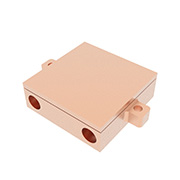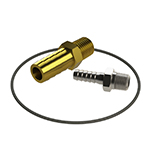Water Blocks / Liquid Cold Plates

Water blocks, also known as Liquid Cold Plates, are the most efficient method of heat removal. They are often 4-5 times more efficient compared to a standard air cooled heat sink and fan. The principle is simple: you provide a source of cool liquid (typically water, or ethylene glycol/water, or Fluorinert) to the inlet of the water block. The liquid travels back and forth through the various chambers of the water block thereby absorbing the heat from the TECs or power electronics. The warmer liquid then exits the water block. The source of the liquid can be;
- Chiller Liquid - A pre-chilled Liquid (typically alcohol, water/glycol, oil, or a dielectric fluid such as Fluorinert) from a recirculating chiller passes through the water block and then is returned to the chiller for re-cooling. This is a closed loop system.
- Radiator closed loop - a liquid enters the water block at close to ambient air temperatures. The exiting warm liquid then goes to a fan cooled radiator of sufficient size to cool the liquid back down to ambient air temperature. The liquid is then sent back through the water block, This is a closed loop system.
- Building (tap) water - This water is usually cooler than the ambient air temperature. The warmer exiting water can be sent to a drain or re-used in a number of ways.
- Well water, lake, or stream water - This water usually requires pre-filtering but can be substantially colder than ambient air temperature, especially during winter months. Exiting water can either be returned to the source or re-used. This is an especially useful method for Off Grid locations.
Liquid cold plates are usually made from either Aluminum or Copper due to their high thermal conductivity. Aluminum liquid blocks are a good all purpose material choice and will suit most needs. Copper liquid cold plates have a thermal advantage in a greater ability to move heat. In addition, it is best to NOT mix metals in a liquid cooling loop as this may cause galvanic corrosion. If you already have brass and/or copper fittings then use a copper cold plate. If you have aluminum, stainless steel, and nickel fittings, then use an aluminum liquid cold block. All of our aluminum liquid cold plates are anodized for corrosion protection. Our copper cold blocks are supplied uncoated (raw) but can be plated if needed. Please call or email for further information. FAQ on Water Blocks / Liquid Cooling Blocks.
Liquid cooling plates ( Water Blocks ) are used as a cooling solution for TECs, TEGs, IGBTs, MOSFETS, thyristors, SiC, data centers, EV/HEV, alternate energy, battery systems, power electronics and anything that needs a compact highly efficient means of heat removal.
Liquid cold plates can also be used in a reverse purpose. By cooling the block or plate with Peltier devices (or a compressor based refrigeration system), any liquid that is passed through the plate becomes chilled. This is the basis behind making a chiller system. Many customers have used this method of regulating the temperature of a desired liquid or gas before it is subjected to analysis. By using thermoelectric devices, the temperature of the fluid can be either heated or cooled to a specific temperature.
Water Blocks are also called; Liquid Cold Plate, Water Cooled Plate, Liquid Chassis, Liquid Cooling Plate, Water Cooling Block, Cold Plates, Liquid Cooled Baseplate, and many others and are all the same basic device that uses a liquid to keep it cool.
-
 $137.50 As low as: $113.10
$137.50 As low as: $113.10 -
 $116.50 As low as: $95.90
$116.50 As low as: $95.90 -
 $208.50 As low as: $171.50
$208.50 As low as: $171.50




